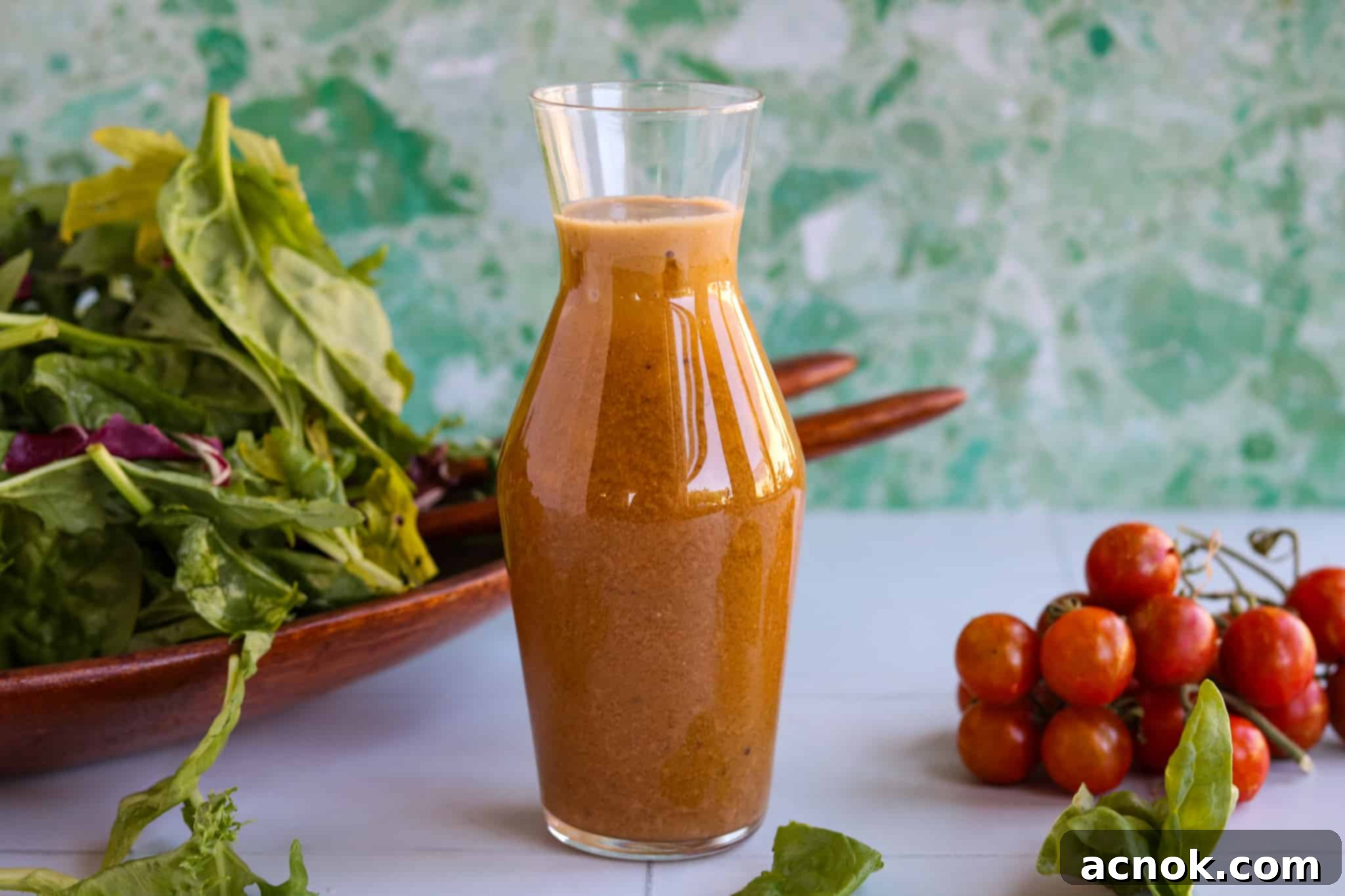Master the Art of Homemade Balsamic Vinaigrette: Your Ultimate Guide to Flavorful Dressings
Elevate your everyday meals with a classic homemade Balsamic Vinaigrette. This essential salad dressing is more than just a topping; it’s a versatile culinary staple that should undoubtedly be a cornerstone of your recipe collection. Crafting your own vinaigrette weekly ensures a fresh, vibrant flavor that store-bought versions simply can’t match. The delightful harmony of tart and sweet balsamic vinegar, perfectly complemented by rich extra virgin olive oil, forms the base of this exquisite dressing. A dash of pantry spices and a hint of Dijon mustard come together to create a perfectly balanced and incredibly versatile vinaigrette that can transform a simple bowl of greens into a gourmet experience. Beyond salads, its robust flavor makes it ideal for pasta salads, marinating proteins, or enhancing heartier dishes like a Chopped Antipasto Salad, making it an indispensable part of your kitchen repertoire.
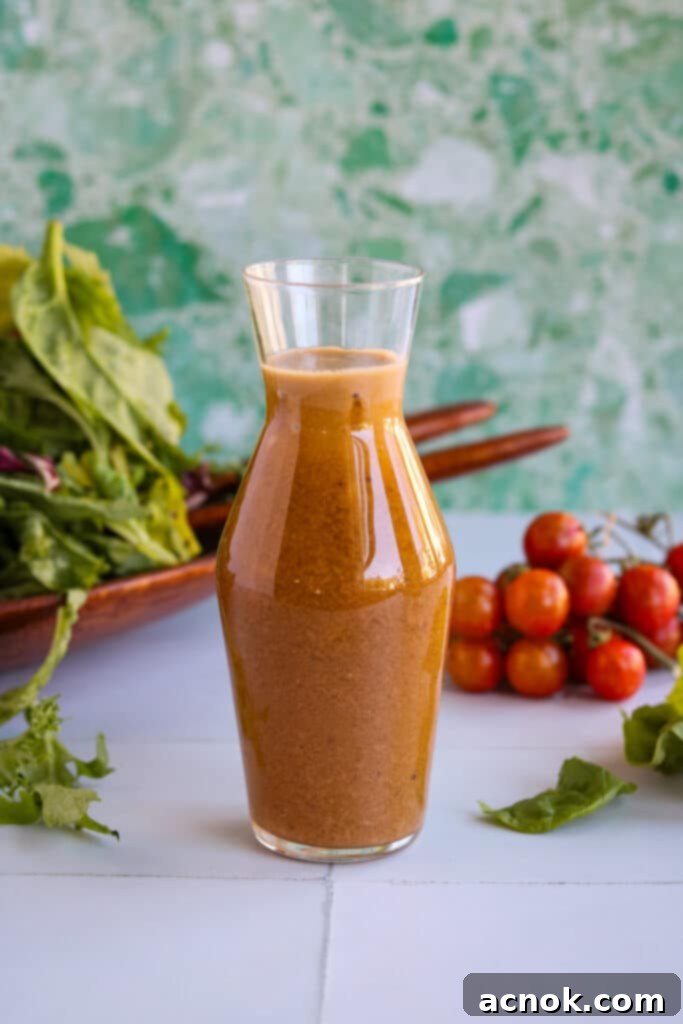
Table of contents
- Types of balsamic vinegar and how to use it
- Ingredients for Balsamic Vinaigrette
- Equipment
- How to make Balsamic Vinaigrette
- Best salad combinations for Balsamic Vinaigrette
- How to store
- Frequently asked questions
Types of Balsamic Vinegar and How to Use It
Balsamic vinegar has become an indispensable staple in my kitchen, especially since I started living on the East Coast. Its unique profile – a perfect blend of tartness, sweetness, and a rich, complex depth – makes it incredibly versatile, and I find myself reaching for both regular and white balsamic vinegar almost daily. This homemade balsamic vinaigrette, for instance, is not just for salads. I regularly use it to marinate chicken, adding a beautiful tang and tenderizing effect. It’s fantastic for creating flavorful side dishes like my Simple Green Bean Tomato Salad, and of course, it’s the perfect dressing for all sorts of salad greens. Beyond that, a good balsamic makes an excellent dip for crusty bread, or a delightful drizzle over components of my Ultimate Antipasto Platter, enhancing everything from cheeses to cured meats.
True balsamic vinegar, particularly traditional varieties, originates from Italy and is aged over many years, much like a fine wine. This aging process contributes to its varying grades and distinct characteristics. Understanding these differences can significantly impact the flavor and quality of your dishes. There are three primary classifications of Balsamic Vinegar that you’ll typically encounter: Traditional Balsamic Vinegar, Balsamic Vinegar of Modena, and Commercial grade.
Traditional Balsamic Vinegar (Aceto Balsamico Tradizionale): This is truly the “best of the best,” produced under strict regulations in Modena or Reggio Emilia. It’s made from cooked grape must (unfermented grape juice) and aged for a minimum of 12 years, often up to 25 years, in a series of different wood barrels. The result is a thick, syrupy, incredibly robust, and complex vinegar with very low acidity and a deeply nuanced flavor profile. Its richness and depth are unparalleled, making it precious and often quite expensive. Traditional balsamic is best savored in small quantities, drizzled over aged cheeses, fresh berries, or grilled meats, where its unique qualities can truly shine.
Balsamic Vinegar of Modena (Aceto Balsamico di Modena IGP): This grade is more widely available and what most people find in mid-range grocery stores, including many well-known brands. While it also comes from Modena, its production methods are less stringent than traditional balsamic. It’s a blend of grape must and wine vinegar, aged for at least 60 days (or three years for “aged” versions). The quality can vary significantly, so it’s important to look for a higher percentage of grape must on the label and fewer additives. This is an excellent everyday balsamic, perfect for vinaigrettes, marinades, and general cooking, offering a good balance of tartness and sweetness without the intensity or cost of traditional varieties.
Commercial Grade Balsamic Vinegar: This is the lowest grade, often found in larger bottles at lower price points. These vinegars typically have a lighter texture, higher acidity, and a less balanced flavor profile, often containing added caramel coloring, sweeteners, or other additives to mimic the appearance and taste of higher-quality balsamic. While they can be used for cooking, they lack the depth and complexity desired for a truly outstanding vinaigrette. For the best homemade balsamic vinaigrette, I recommend opting for at least a good quality Balsamic Vinegar of Modena.
For my everyday cooking, I consistently turn to O California Balsamic Vinegar, which is aged in oak barrels from Petaluma, along with their White Balsamic vinegar. These have become my go-to choices for their consistent quality and delicious flavor. And speaking of white balsamic, my White Balsamic Honey Mustard Vinaigrette is another incredibly delicious and versatile dressing that highlights the unique characteristics of white balsamic vinegar beautifully.
Ingredients for Balsamic Vinaigrette
Creating your new favorite homemade balsamic vinaigrette requires just a handful of simple, high-quality pantry staples. The key to an exceptional dressing lies in the freshness and quality of each component, which allows their individual flavors to truly shine and meld together harmoniously.
- 1 tablespoon of shallot, finely chopped: Adds a delicate, mild onion flavor and aromatic depth without being overpowering.
- 5 tablespoons Balsamic vinegar: The star of the show. Choose a good quality Balsamic Vinegar of Modena for the best balance of tartness and sweetness.
- 1/2 cup of Extra virgin olive oil: Crucial for emulsification and flavor. Opt for a high-quality, fruity extra virgin olive oil to complement the vinegar.
- 1 tablespoon Dijon mustard: Acts as a natural emulsifier, helping the oil and vinegar combine smoothly, and adds a zesty, piquant note.
- 1 teaspoon of honey or 1/2 teaspoon of granulated sugar: Balances the acidity of the vinegar and enhances the overall sweetness. Adjust to your preference.
- OPTIONAL: pinch of dried Italian herbs: For an added layer of Mediterranean flavor. Think oregano, basil, or a mixed Italian seasoning.
- 1/2-1 teaspoon Kosher salt: Essential for seasoning and bringing out all the flavors. Start with less and add more to taste.
- 1/4-1/2 teaspoon Black pepper: Freshly ground black pepper adds a subtle warmth and aroma. Adjust to your liking.
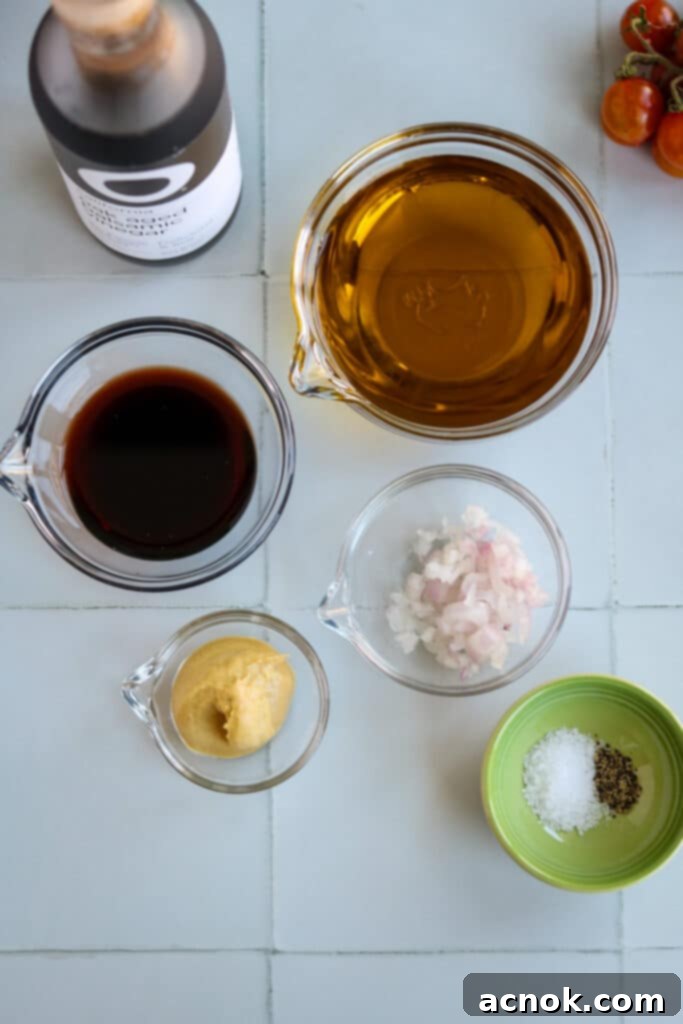
Equipment
While a mini food processor might seem like a luxury for making this Balsamic Vinaigrette, it’s certainly my preferred tool for achieving a beautifully emulsified, creamy dressing with minimal effort. It effortlessly blends all the ingredients into a smooth, cohesive mixture. However, if you don’t have a mini blender or food processor, don’t worry! You can still make an equally delicious vinaigrette using a simple small whisk and a jar or a small bowl. It might require a bit more manual effort and some arm muscle to achieve that lovely emulsification, but the end result will still be a wonderfully flavorful and perfectly blended homemade Balsamic Vinaigrette. The key is patience and consistent whisking.
How to Make Balsamic Vinaigrette
This quick and easy salad dressing comes together in mere minutes, making it a perfect last-minute addition to any meal. Whether you prefer the speed of a food processor or the traditional method of whisking, the steps are straightforward and yield a consistently delicious result.
Using a Food Processor or Stick Blender: This is the fastest way to achieve a perfectly emulsified dressing. Simply add all your measured ingredients – the finely chopped shallot, balsamic vinegar, extra virgin olive oil, Dijon mustard, honey or sugar, optional Italian herbs, Kosher salt, and black pepper – into the bowl of your food processor or the container for your stick blender. Pulse for about 10-15 seconds, or until the mixture is completely smooth and creamy. You’ll notice the vinaigrette transform into a lovely light tan color with a thick, velvety texture. While some separation might occur if it sits for a while, a quick shake or whisk before serving will bring it right back together. Always taste and adjust the seasoning, adding more salt, pepper, or sweetness (honey/sugar) as needed to suit your palate.
Using a Small Bowl and Whisk: If you don’t have a food processor, a bowl and whisk work beautifully with a little more dedication. Start by combining the shallot, balsamic vinegar, Dijon mustard, salt, pepper, and optional dried herbs in a small bowl. Whisk these ingredients together vigorously until well combined. This initial mix helps dissolve the salt and integrate the flavors. Next, and this is crucial for emulsification, gradually stream the extra virgin olive oil into the vinegar mixture in a slow, steady drizzle while continuously whisking. Keep whisking until the dressing thickens and achieves a creamy, cohesive texture. Once emulsified, taste the vinaigrette. Adjust for salt, pepper, and sweetness, adding more honey or sugar if you prefer a sweeter profile. Enjoy the satisfaction of a perfectly balanced dressing made by hand!
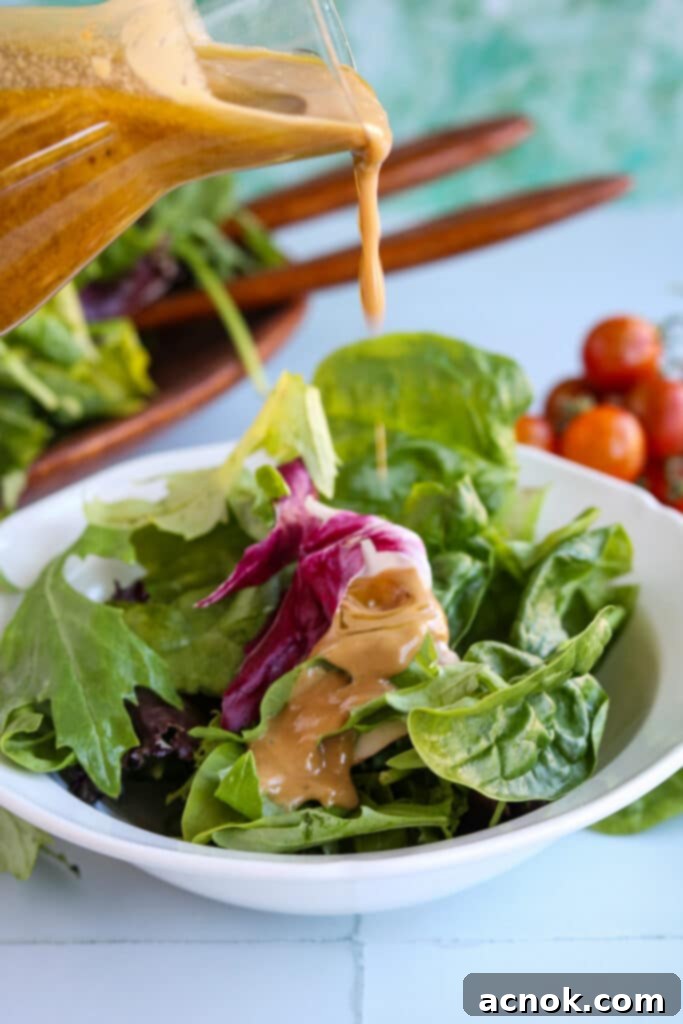
Best Salad Combinations for Balsamic Vinaigrette
As mentioned, this homemade balsamic vinaigrette is a true favorite and one of the most frequently used dressing recipes in my household, and for good reason: its incredible versatility! The balanced sweet and tart notes, combined with the depth of good olive oil and the zest of Dijon, make it a perfect complement to a vast array of ingredients. Here are some of my go-to salad combinations that truly shine with this delightful dressing:
- Spring Mix with Apples, Chicken, and Feta: The crispness of fresh apples, the savory notes of rotisserie chicken, and the salty tang of feta cheese are beautifully unified by the vinaigrette, creating a refreshing and satisfying meal.
- Arugula, Sun-Dried Tomatoes, and Asiago: The peppery bite of arugula is perfectly mellowed by the sweetness of sun-dried tomatoes (especially those packed in oil for extra richness) and the sharp, nutty flavor of shredded Asiago cheese, all brought together by the balsamic.
- Hearts Salad with Prosciutto: This elegant salad benefits from the vinaigrette’s ability to cut through the richness of prosciutto and enhance the tender texture of hearts of palm or artichoke hearts.
- Classic Green Salad: A timeless combination of crisp romaine, juicy chopped tomatoes, cool cucumbers, and crunchy shredded carrots provides a simple yet delightful canvas for the vinaigrette to showcase its clean, bright flavors.
- Spring Mix with Peaches, Goat Cheese, and Walnuts: A truly seasonal delight! The sweetness of fresh sliced peaches, the creamy tang of goat cheese crumbles, and the earthy crunch of walnuts create a harmonious balance of textures and flavors, all elevated by the balsamic dressing.
- Kale Broccolini Roasted Butternut Squash Salad: The robust flavors of roasted vegetables like kale, broccolini, and butternut squash are wonderfully balanced by the vinaigrette’s acidity, making a hearty and healthy salad.
- Caprese Salad Reinvented: Fresh mozzarella, ripe tomatoes, and basil, drizzled with balsamic vinaigrette instead of plain balsamic glaze for a lighter, more vibrant take.
- Mediterranean Chickpea Salad: Chickpeas, chopped bell peppers, red onion, cucumbers, and olives dressed with balsamic vinaigrette for a protein-packed and flavorful meal.
How to Store Homemade Balsamic Vinaigrette
Proper storage is key to maintaining the freshness and flavor of your homemade balsamic vinaigrette. I typically prepare a small batch, yielding a little over a cup, which is perfect for a week’s worth of salads and cooking. The best way to store any leftover vinaigrette is in a clean, airtight jar with a lid or a dedicated salad dressing bottle. This helps to prevent oxidation and keeps the flavors vibrant. Place it directly into the refrigerator, where it will stay fresh for up to five days.
It’s important to note that due to the extra virgin olive oil content, your vinaigrette may solidify or become cloudy in the refrigerator. This is a completely natural occurrence and not a sign of spoilage. If this happens, simply run the jar or bottle under warm water for a minute or two, or let it sit at room temperature for about 15-20 minutes. Once it returns to a liquid state, give it a good shake or a quick whisk to re-emulsify before serving. Making vinaigrette in small batches ensures optimal freshness and flavor, so you can always enjoy the best quality dressing with your meals.
Frequently Asked Questions
Yes, this homemade balsamic vinaigrette recipe is naturally gluten-free. Authentic vinegars, including balsamic, are inherently gluten-free. However, it’s always a good practice to double-check the labels of any store-bought ingredients you use, especially lower-grade balsamic vinegars or mustards, to ensure there are no hidden additives or thickeners that might contain gluten. Opting for higher-quality ingredients generally reduces the risk of such additives.
No, they are distinct. Balsamic vinegar is a single ingredient – a type of aged grape vinegar – known for its distinctive dark color and sweet-tart flavor. Balsamic vinaigrette, on the other hand, is a dressing or sauce that uses balsamic vinegar as its primary flavor component, typically combined with extra virgin olive oil, an emulsifier like Dijon mustard, and seasonings such as salt, pepper, and sometimes a touch of sweetness.
Absolutely! The addition of honey or granulated sugar is entirely optional and depends on your personal taste preference and the specific balsamic vinegar you are using. Some balsamic vinegars are naturally sweeter than others. I often make this dressing without any added sweetener, especially when I’m using a particularly rich or naturally sweet balsamic, or when I prefer a more robustly tart flavor profile.
While Dijon mustard primarily acts as an emulsifier and adds a pleasant tang, you can omit it. If you do, consider using 4 tablespoons of balsamic vinegar and 1 tablespoon of apple cider vinegar instead of 5 tablespoons of balsamic. The apple cider vinegar will add a bit more acidity to help balance the oil, and you will need to whisk more vigorously to achieve emulsification. Alternatively, a tiny amount of mayonnaise or even a mashed avocado can act as an emulsifier.
A common mistake is rushing the emulsification process, especially when whisking by hand. Slowly drizzling in the olive oil while continuously whisking is key. Another mistake is not tasting and adjusting the seasoning. Balsamic vinegars vary greatly in sweetness and acidity, so always taste and adjust salt, pepper, and sweetener to achieve your desired balance. Using low-quality ingredients, particularly olive oil and balsamic vinegar, can also result in a less flavorful dressing.
While this recipe is a classic oil-based vinaigrette, you can certainly experiment with lower-oil versions. For a low-oil option, you can reduce the amount of extra virgin olive oil and increase the balsamic vinegar slightly. For an oil-free approach, you would need to replace the oil with a different liquid base and rely on other ingredients for texture and richness, such as pureed roasted vegetables, avocado, or a nut butter, though this would significantly change the nature of a traditional vinaigrette.
If you’re a true enthusiast of balsamic vinegar’s rich and complex flavor profile, you’ll love exploring other ways to incorporate it into your cooking. Be sure to try my Simple Balsamic Roasted Vegetables, which brings out the natural sweetness of vegetables, and my hearty Balsamic Roasted Vegetable Grain Salad. For grilling season, don’t miss the diverse applications in Balsamic Grilled Vegetables (3 Ways), and to add a pop of flavor to sandwiches or salads, my Marinated Balsamic Red Onions are a must-try.
If you tried this versatile and delicious homemade balsamic vinaigrette recipe, please help other readers by commenting below and sharing some stars! We 🫶🏼 appreciate you! Your feedback helps our community discover and enjoy these recipes.
All content and photographs ©Claudia’s Table and claudiastable.com
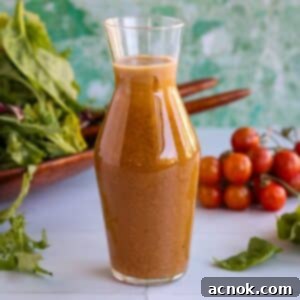
Balsamic Vinaigrette
Ana | Claudia’s Table
September 4, 2024
Pin Recipe
Equipment
-
1 mini food processor optional, for best emulsification
-
1 bowl small, if whisking by hand
-
1 whisk small, if whisking by hand
-
1 jar with lid or dressing bottle for storage
Ingredients
- 1 tablespoon shallot finely chopped
- 5 tablespoons Balsamic vinegar good quality is recommended
- 1/2 cup Extra virgin olive oil high quality for best flavor
- 1 tablespoon Dijon mustard
- 1 teaspoon honey or 1/2 teaspoon granulated sugar, optional for sweetness
- pinch dried Italian herbs OPTIONAL, for added aroma
- 1/2-1 teaspoon Kosher salt to taste
- 1/4-1/2 teaspoon Black pepper freshly ground, to taste
Instructions
How to make Balsamic vinaigrette with a mini food processor
-
If using a food processor or stick blender, add all the ingredients (shallot, balsamic vinegar, extra virgin olive oil, Dijon mustard, honey/sugar, optional herbs, salt, and pepper) to the processor bowl.
-
Pulse for 10-15 seconds until all ingredients are completely emulsified. The vinaigrette will become a light tan color and creamy in texture.
-
Taste the dressing and adjust for salt, pepper, and sweetness (honey or sugar) to your preference. If separation occurs later, simply shake well before serving.
How to make Balsamic vinaigrette in a bowl with a whisk
-
In a small bowl, combine the finely chopped shallot, balsamic vinegar, Dijon mustard, optional dried herbs, Kosher salt, and black pepper. Whisk these ingredients together thoroughly.
-
Now, slowly and gradually drizzle the extra virgin olive oil into the vinegar mixture while continuously whisking. Maintain a steady stream and consistent whisking until the mixture is fully emulsified and thickens.
-
Taste the vinaigrette and adjust for salt and pepper. If you desire a sweeter dressing, add more honey or sugar, a little at a time, until it suits your taste.
Notes
For optimal flavor, use high-quality balsamic vinegar and extra virgin olive oil. This vinaigrette can be made ahead and stored in the refrigerator.
Nutrition
Nutritional information is calculated online and should be used as a guide.
All content and photographs ©Claudia’s Table and claudiastable.com
Check out our New & Delicious posts below
- Pasta with Grilled Vegetables, Feta, and Lemon
- Grilled Asian Marinated Flank Steak
- Classic Homemade Chunky Blue Cheese Dressing
- 3-Ingredient Crispy Oven-Roasted Potatoes
- Grilled Peach Avocado Chicken Salad
